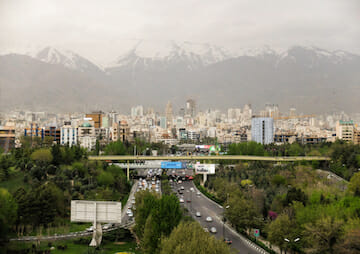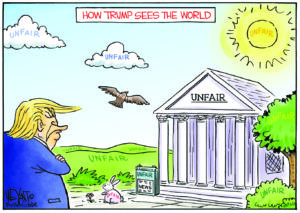Trump Administration Announces New Sanctions Against Iran
The action comes on the heels of Washington's reluctant recertification of Tehran's compliance with the 2015 nuclear deal. Tehran, capital of Iran, in April. (Flickr / CC 2.0)
Tehran, capital of Iran, in April. (Flickr / CC 2.0)
Tehran, capital of Iran, in April. (Flickr / CC 2.0)
The Trump administration on Tuesday released a slate of new economic sanctions against Iran over that nation’s ballistic missile program. These latest sanctions were publicized just a day after the administration announced that it would “grudgingly” recertify Tehran’s compliance with the 2015 nuclear deal, which had relaxed previously enforced sanctions in exchange for a verifiable decrease in nuclear activities.
“The United States remains deeply concerned about Iran’s malign activities across the Middle East, which undermine regional stability, security, and prosperity,” read Tuesday’s statement.
The New York Times reports that President Trump had railed against the nuclear deal reached under President Obama, calling it a disastrous giveaway to Iran and suggesting during his 2016 presidential campaign that he would tear it up.
The Times continues:
But parties to the agreement also include Britain, China, France, Russia and Germany, which do not share Mr. Trump’s objections. An American withdrawal would leave the United States isolated on the issue.
Moreover, the nuclear agreement is monitored by the International Atomic Energy Agency of the United Nations, which has repeatedly found Iran to be in compliance despite Mr. Trump’s assertions that Iran is not adhering to “the spirit” of the agreement.
So Mr. Trump has sought to find new ways to challenge Iran, and his administration had suggested it would be adding names to its non-nuclear sanctions blacklist as part of that strategy.
The White House’s latest restrictive action against Iran specifically targets 16 entities and individuals designated by the U.S. Treasury Department as supporting “illicit Iranian actors or transnational criminal activity.” Some of those targeted had supported the Iranian military or Iran’s Islamic Revolutionary Guard Corps (IRGC).
“This administration will continue to aggressively target Iran’s malign activity, including their ongoing state support of terrorism, ballistic missile program, and human rights abuses,” Treasury Secretary Steven Mnuchin said, adding that the sanctions “send a strong signal that the United States cannot and will not tolerate Iran’s provocative and destabilizing behavior. We will continue to target the IRGC and pressure Iran to cease its ballistic missile program and malign activities in the region.”
Many opponents have pointed out the historical ineffectiveness, and often counterproductivity, of bringing sanctions against Iran. Foreign Minister Mohammad Javad Zarif of Iran, who spoke on Monday to a forum sponsored by the Council on Foreign Relations, took up this argument:
Your support matters…The United States should reconsider its approach to sanctions. Sanctions have never been an asset for the United States. Sanctions are a liability. You see, when you started imposing nuclear sanctions on Iran—when the U.S., I’m sorry to say you—when the U.S. government started to impose nuclear sanctions against Iran, we only had 200 centrifuges. When they started negotiating with us in order to remove those sanctions, we had 20,000 centrifuges. So if you want to see the results of sanctions, just 19,800 centrifuges is the net result of sanctions.
Independent journalism is under threat and overshadowed by heavily funded mainstream media.
You can help level the playing field. Become a member.
Your tax-deductible contribution keeps us digging beneath the headlines to give you thought-provoking, investigative reporting and analysis that unearths what's really happening- without compromise.
Give today to support our courageous, independent journalists.






You need to be a supporter to comment.
There are currently no responses to this article.
Be the first to respond.